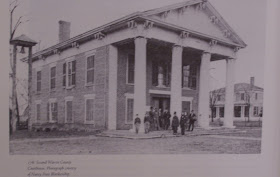 |
| The Virginia State Capitol during the Civil War. Photo Virginia Historical Society. |
It was the early 1970s. On any given night — or broad daylight for that matter – young
men roamed Hay Street, “Fayettenam’s” main drag, seeking alcohol, drugs and
women. They found all in abundance,
just as Civil War soldiers found them on the mean streets of Washington, D.C.; Memphis,
Tennessee; and Richmond, Virginia, in the early 1860s.
I can imagine the scene along Richmond’s Broad Street in
1862 because I worked along Fayetteville’s notorious Hay Street in 1972, soon
after President Nixon authorized a massive bombing campaign against North
Vietnam. During both wars, people
compared the Southern cities to the wicked biblical city, Sodom. From what I know, the comparisons seem
justified. Hay Street in the early seventies out-sleazed Boston's Combat Zone and New Orleans' Bourbon Street combined.
 |
| The author as a young reporter, right, about to experience a PR ride aboard a reconnaissance helicopter at Fort Bragg in 1972. Photo, U.S. Army. |
Working in Fayetteville, I’d sometimes stand on the
curb in front of The Fayetteville Observer where I worked, located downtown then, waiting to
cross Hay Street to grab lunch at a storefront diner. There I stood, Bambi, with
a polyester miniskirt up to here and brown hair down to there, within a stone’s
throw of the railroad station where prostitutes gathered every morning to ply
their trade.
“Hey, how much you charge for all of us, baby?” The
question usually came from a GI among a carload of grinning GIs cruising Hay Street.
On the sidewalks, shotgun-carrying cops roamed among stoned
soldiers and sleazy men wearing purple fedoras and long coats, impervious to sandy-soiled
Fayetteville’s infamous heat. With a little prompting, one of these street
capitalists might open his coat to reveal gold watches, bags of heroin and pills, vials
and syringes pinned to the lining.
"What for you today?" he'd ask.
Near-naked women danced in the windows of a bar that once was a clothing store. Loud, throbbing music beckoned boys into smoky, beer-humid joints where any women patronizing the trough could strip on a tabletop in exchange for greenbacks, a drink or the next hit.
"What for you today?" he'd ask.
Near-naked women danced in the windows of a bar that once was a clothing store. Loud, throbbing music beckoned boys into smoky, beer-humid joints where any women patronizing the trough could strip on a tabletop in exchange for greenbacks, a drink or the next hit.
Routinely, sirens screamed from a “Vomit Comet,” one of many shuttle vans between the army base and Hay Street. MPs jumped from the Comet to harvest the near-lifeless
bodies that managed to crawl out of the bars and prop against streetlights. The
MPs wordlessly threw the bodies into the van; the driver revved the engine and they continued their rounds.
In the 1860s, as the Civil War ramped up, Richmond’s
population exploded from about 38,000 people to possibly triple that. An
estimated 10,000 to 15,000 troops, fighting fear and frustration, waited in
camps for fighting orders, as did Confederate ancestors, whom I'm writing about in my book-in-progress, Dear Father I Am Sorry To Tell You. The Confederate capital harbored hundreds of
brothels, saloons, gambling halls, speculators, criminals of all stripe and
women of the night. The women trolled the grounds of the state capitol, modeled
after an ancient Roman temple, offering their bodies.
Farm boys, some separated for the first time from parents, wives, sweethearts and ministers, dared to dance with the devil. They paid with
sexually transmitted diseases, injuries sustained in fights and industrial-strength guilt. Enemies attacked the soldiers before they ever entered a combat zone.
 |
| Hay Street, Fayetteville, N.C.'s upscale main drag today |
Virginia’s capital today (see PHOTOS page) stands among my favorite
destinations, not only for its rich history from our nation’s earliest days,
but for its fine old homes, its trendy eateries and shops in the Shockoe Bottom district along the James River, bustling universities, Civil War parks and landmarks, and Edgar Allen Poe’s neighborhood.
Fayetteville years ago revitalized its downtown and repaired its military-gone-wrong image. The red brick Rubik's cube that once
housed the Fayetteville Observer is gone, replaced by the Airborne and Special Operations Museum . Honky-tonks and seedy hotels have given way to coffee
emporiums and al fresco dining along a brick esplanade. Civil War sites
have been revived 150 years after Union General Sherman left his mark.
When I visited Fayetteville recently to research the Civil
War for my book (and visit my sister, who lives nearby), I
marveled at how the city has erased vestiges of Hay Street's Vietnam War days
while emphasizing its Civil War days at nearby parks and museums, just as Richmond has done.
But my memory of "Fayettenam" and my study of Virginia’s Sodom-of-Yore reminded me there are no new tricks on the mean streets of war. They span history,
they endure, and there's always a ransom to be paid.
###
NOTE: The Virginia State Capitol Visitor Center is
hosting an exhibition presented by the Library of Virginia titled "The
Struggle to Decide: Virginia's Secession Crisis," from December 13, 2010
to October 29, 2011. For information, go to Virginia State Capitol.
SOURCES: Virginia Historical Society; Confederate White House, Richmond, Virginia










